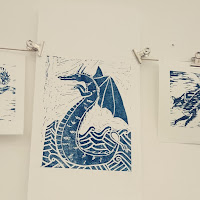Unicorn - Darcie Couch (UP784365)
Choosing an animal for this project proved difficult as many of the animals I had considered had a range of possibilities in regards to producing a final outcome. In the end I decided to study my project on a Unicorn because although finding primary resources would be difficult, I would have had a fluid approach to experimentation.
I began to work on the unicorns appearance, studying its poise and characteristics. As the Unicorn is a mythical animal it wasn't surprising to see that there were many varying illustrations/photos, showing different features in each; such as having wings or horns. These were initial studies I made using the references of what a Unicorn is described to look like. The varied mediums used and mark making explored what I felt would best successfully represent the Unicorn image.
I closely looked into comparing Horses and Unicorns. I made a study of a Horse using only white ink on brown paper. Making this study made it easier to compare the appearances of both animals, especially with their similarities in facial features.
Later on in the project I looked into more than the similarities and made both mathematical and scientific diagrams on their hooves, skulls and torsos. In the picture above I've included the hooves and shoes with their diagram labels and angular measurements. I found studying the contrast between the myth and the math fascinating because it dipped into key points of the broad projects spectrum.






















